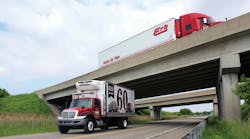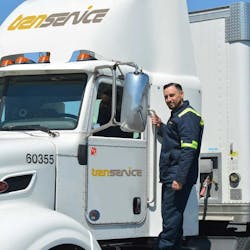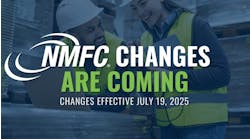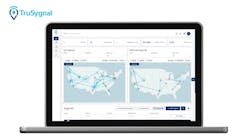Transervice
Being a driver at Transervice is not just about being behind the wheel. That thinking—part of the approach to driver training at the Lake Success, New York-based company—fits with the ability to provide a range of freight hauling services and field 525 tractors and 1,800 trailers at 21 facilities across North America.
“Hauling dedicated freight means we’re contracting with companies that have a wide array of needs,” said Mark Finger, VP of operations. “Our approach to training drivers takes into account that broad spectrum of customers and different types of operations. Likewise, as it relates to advancing employees to become drivers, there are also different CDL training requirements that may vary by state to consider.”
When asked to describe the range of freight that Transervice hauls, Finger said it runs from live hogs to commercial garage doors and everything in between. That means operating a variety of trailers, including some with specialized equipment for loading, unloading, and securing loads.
“Our roughly 700 drivers all start training with a wide view of things like hours-of-service regulations, and our safety department takes them through materials we’ve developed internally,” Finger related. “Training is provided for common topics such as space management and is also tailored to local, regional, and long-haul operations, and load securement in different types of equipment.”
Finger noted that ongoing communication with Transervice drivers keeps them engaged and makes safety awareness top of mind. Training is also continually evolving. “We’re using technology like in-cab cameras and telematics data to develop coaching opportunities that enable our drivers to continually improve their performance,” he said.
Halvor Lines
Halvor Lines firmly believes that driver satisfaction helps drive the company’s success. Bob Knaeble, senior CDL training manager, noted the diversified carrier’s approach to training is focused on professionalism and a commitment to on-time deliveries.
Headquartered in Superior, Wisconsin, Halvor Lines is a family-run trucking company that provides flatbed, van, decked van, and refrigerated services. It fields more than 400 tractors across the continental U.S. and Canada through seven Midwestern terminals.
Halvor Lines' drivers undergo a series of training courses geared toward specific aspects of the carrier’s operation. For example, there are classes on flatbed cargo securement and proper loading of ATVs when hauling loads for motorsports customers. In addition, all drivers must take eight hours of paid training in the Smith System defensive driving course with one of the company’s five certified instructors.
“Our training continues to evolve, but a common thread has been to work with CarriersEdge,” Knaeble said. “We use their online driver training modules for new driver orientation and continuing education, and some of our own content is deployed through their platform. That is one of the reasons we chose CarriersEdge.”
Orientation modules provided by CarriersEdge to Halvor Lines drivers cover a range of required topics and company policies, C-TPAT for cross-border operations, and security and threat awareness.
“We also have a safety team that works with drivers individually, and if they see a need for training in one area, they choose from a list of training modules,” Knaeble related. “The refresher courses are taken online through the CarriersEdge portal, which our drivers like since they can use their laptop or tablet when it’s most convenient.”
Before it put the CarriersEdge online platform in place, Knaeble noted, Halvor Lines used safety and training videos. “While that meant drivers saw a video, they didn’t absorb the content,” he said. “With online training and testing, they retain the information.”






